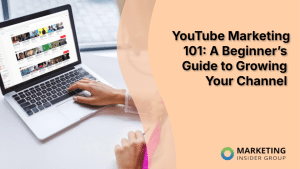
YouTube is more than just a platform for sharing videos. It’s a powerful marketing tool that, when used strategically, can skyrocket your brand’s visibility, engagement, and authority. Whether you’re a creator, a small business owner, or a marketer, understanding the fundamentals of YouTube marketing is essential. In this guide, we’ll explore key strategies to make your channel stand out, from content planning to analytics, promotion, and even automation.
1. Define Your Goals and Audience
Every successful marketing effort begins with clarity. Ask yourself:
- What are you trying to achieve? Brand awareness, subscriber growth, leads, sales, or engagement?
- Who is your ideal viewer? What are their interests, demographics, and viewing behaviors?
By defining your goals and audience from the outset, you’ll make decisions about content type, tone, upload schedule, and promotion tactics much more precise and effective.
2. Plan High-Quality, Value-Driven Content
YouTube’s discovery system rewards content that keeps viewers engaged. Plan your videos with intention:
- Value and relevance: Teach, entertain, inform, or solve problems—make your audience feel like the time they spend with you is worthwhile.
- Structure: Hook viewers in the first 10–15 seconds, deliver your main message clearly in the middle, and end with a compelling call to action (e.g., “Visit our website,” “Like and subscribe,” or “Watch the next video”).
- Consistency: Whether it’s weekly, biweekly, or monthly, establish and stick to a publishing schedule. Consistency helps with audience retention and algorithm favors.
3. Optimize for Discovery: SEO on YouTube
YouTube is the world’s second-largest search engine—after Google—so SEO matters. Improve your discoverability through:
- Titles: Use relevant keywords while maintaining clarity and curiosity (“How to Edit Videos Like a Pro” vs. “Video Editing Tips”).
- Descriptions: Provide context with 2–3 short paragraphs, include primary keywords, and add timestamps, links, and captions when applicable.
- Tags and hashtags: Choose a mix of broad and specific tags, and use relevant hashtags (e.g., #YouTubeTips, #VideoMarketing).
- Thumbnails: Create eye-catching, high-contrast visuals with readable text overlays. Faces and bold colors tend to attract more clicks.
- Playlists: Group related videos into playlists to boost watch time and keep viewers on your channel longer.
4. Engage with Your Viewers
YouTube thrives on interaction. Engagement signals like likes, comments, and watch time help the algorithm.
- Call to action: Encourage viewers to like, comment, and subscribe—or ask them a question to spark discussion.
- Community tab: Once available, post polls, updates, or behind-the-scenes content to deepen connection.
- Respond to comments: Even a brief reply shows you’re listening—and it encourages more engagement.
- Live streams and premieres: These are great tools for real-time interaction, building hype, or launching key content.
5. Analyze and Adapt: Leverage YouTube Analytics
Understanding your video performance allows you to fine-tune your strategy. Dive into metrics like:
- Watch time & average view duration: Identify where viewers drop off.
- Traffic sources: Are viewers coming from search, suggested videos, external sites, or social media?
- Audience retention & demographics: Who’s watching, and which parts retain attention best?
- Engagement metrics: How are likes, comments, shares, and subscribers trending?
To take your analysis further, you might explore analytics for other channels—tools that help you measure competitors’ performance and benchmark your own.
6. Collaborate, Cross‑Promote, and Leverage Other Platforms
- Collaborate with creators in your niche to tap into new audiences through guest appearances, interviews, or challenges.
- Cross‑promote on platforms like Instagram, Twitter, TikTok, or LinkedIn with teaser clips, behind-the-scenes content, or links to your YouTube videos.
- Leverage email marketing: Embed your latest videos in newsletters to drive traffic and allow subscribers to engage directly.
7. Promote Effectively with Ads (Optional)
Paid promotion can give your content an extra boost, especially when starting or launching major campaigns. YouTube’s advertising tools let you:
- Target granular demographics, interests, or behaviors
- Choose ad types like skippable in-stream ads, non-skippable ads, bumper ads, or discovery ads
- Set budgets by cost-per-view (CPV) or daily caps
If your channel grows large enough, exploring YouTube automation—tools for scheduling, uploading, or data-driven process optimization—might be a great add-on to streamline your workflow.
8. Experiment with Formats and Trends
Stay flexible and test different content formats to see what resonates:
- Shorts or Reels: Fast, vertical videos that grab attention quickly.
- Tutorials and how-tos: Honest, step-by-step content often delivers strong value.
- Storytime or personal vlogs: Great for building authenticity and emotional connection.
- Trend-based content: Use trending sounds, memes, or challenges—but always tie it back to your brand or message.
Test titles, thumbnails, or even calls to action—then iterate based on performance.
9. Stay Consistent, Patient, and Data-Driven
YouTube success doesn’t always happen overnight. Be patient, ready to adapt, and let the data lead. Track the performance of new strategies, replicate what works, and quietly drop what doesn’t.
- Regularly revisit your analytics to see what’s changing.
- Set benchmarks (e.g., average view duration or monthly subscriber growth) and measure against them.
- Celebrate small wins, and always look for opportunities to optimize.
Wrap-Up
YouTube marketing starts with a clear strategy: define your goals and audience, create consistent, value-rich content, and optimize for discovery and engagement. Use analytics smartly, experiment with styles and formats, and stay adaptive—automating parts of your workflow as your channel grows can help you scale without burning out.
Key takeaways:
- Clarify your content strategy and audience.
- Focus on value and consistency in your publishing.
- Optimize titles, thumbnails, and metadata for search.
- Engage with your audience and encourage interaction.
- Analyze what’s working—and what isn’t.
- Promote creatively and consider paid advertising.
- Embrace new formats and trends.
- Automate wisely as you grow.
Ready to start your YouTube journey with confidence? With a solid foundation and consistent effort, you’re well on your way.





